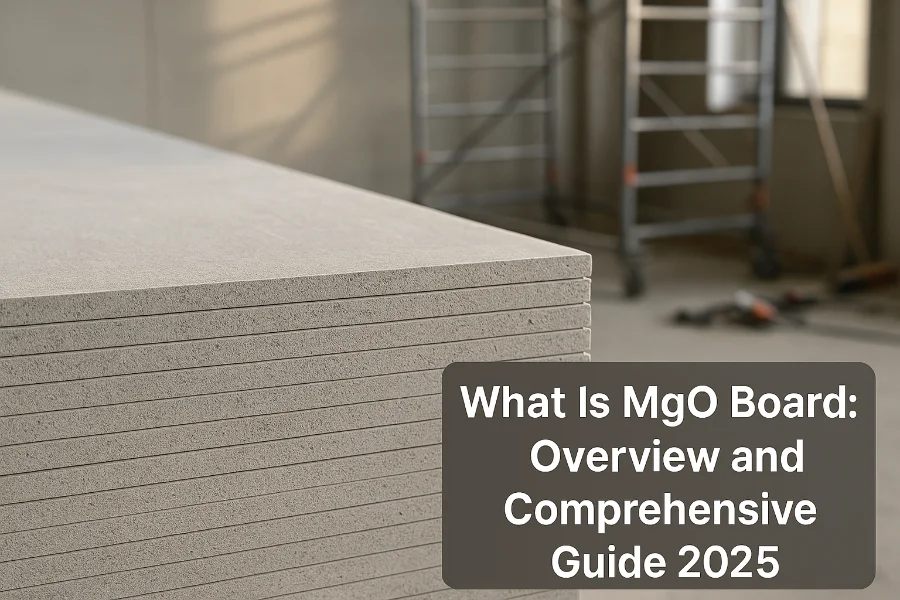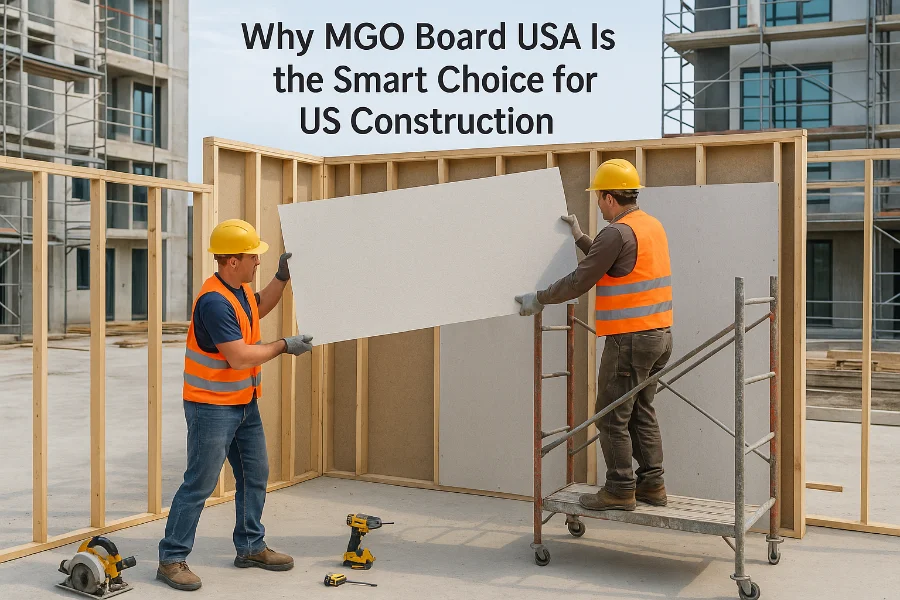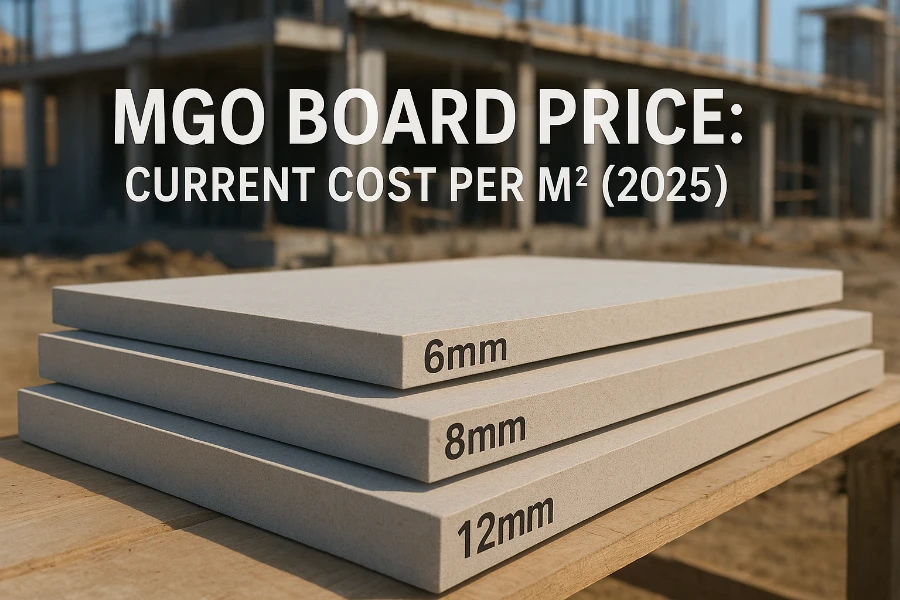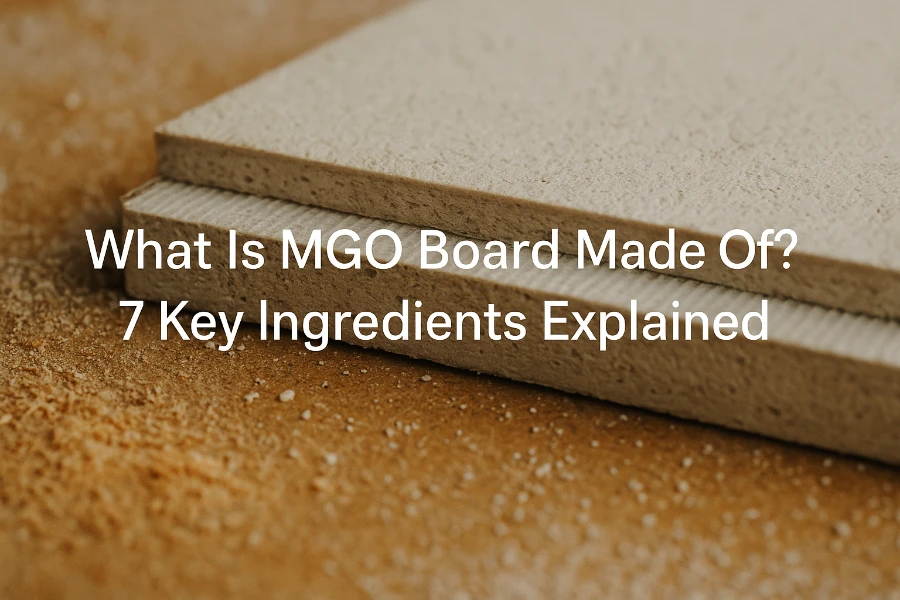Table of Contents
Introduction
Magnesium oxide board, commonly referred to as MgO board, has rapidly gained attention in the construction industry due to its unique combination of strength, fire resistance, and environmental friendliness. For builders, architects, and designers, understanding what is MgO board and how it can be applied is essential in 2025’s modern building landscape.
Unlike traditional gypsum or cement boards, MgO board offers superior durability, making it a reliable choice for both residential and commercial projects. In this comprehensive guide, we will explore its composition, benefits, applications, installation tips, and practical advice for selecting the right board for your project. By the end of this article, you will have a full understanding of what is MgO board and why it is increasingly becoming a preferred material worldwide.
What Is MgO Board? Definition and Composition
Definition
MgO board, or magnesium oxide board, is a type of rigid panel made primarily from magnesium oxide (MgO) derived from natural magnesite, combined with various binders, fillers, and reinforcing fibers. Its chemical composition gives it unique properties that traditional drywall or cement boards cannot match. Understanding what is MgO board is crucial for specifying the right material in fire-rated walls, ceilings, or flooring systems.
Key Characteristics
MgO boards stand out due to several distinctive features:
-
Fire Resistance – MgO is naturally fireproof, capable of withstanding high temperatures without structural damage.
-
Moisture Resistance – Unlike gypsum boards, MgO boards resist swelling and mold growth, making them suitable for humid environments.
-
Strength and Durability – Reinforced with fibers or mesh, these boards have higher impact resistance and long-term dimensional stability.
-
Eco-Friendly Material – MgO boards are non-toxic, low in VOC emissions, and in some cases, cement-free, making them a greener choice for sustainable construction.
-
Versatility – Available in various thicknesses, finishes, and sizes, MgO boards can be used for interior partitions, exterior walls (sheltered), floor underlayment, and as tile backing.
By knowing what is MgO board and its composition, builders can choose the right type for their project, ensuring safety, durability, and compliance with building codes in 2025.
Benefits of MgO Board
Magnesium oxide board offers a wide range of advantages over traditional construction panels. Understanding these benefits helps builders and architects decide why MgO board is increasingly preferred in 2025 projects.
1. Exceptional Fire Resistance
One of the most significant benefits of MgO board is its outstanding fire resistance. Unlike gypsum or cement boards, MgO can withstand prolonged exposure to high temperatures without warping or losing structural integrity. This makes it an ideal choice for fire-rated walls, ceilings, and shafts. Many building codes now recognize MgO boards for passive fire protection in commercial and residential projects.
2. Moisture and Mold Resistance
MgO boards are highly resistant to moisture absorption, which prevents swelling, delamination, and mold growth. This property is particularly valuable in kitchens, bathrooms, basements, and other humid environments. By using MgO boards, builders can ensure longer-lasting interiors and reduce maintenance costs over time.
3. Strength and Durability
Reinforced with fiberglass or other natural fibers, MgO boards offer superior impact resistance compared to gypsum boards. They maintain their shape under stress, resist cracking, and provide a robust surface for finishing. Flooring underlayment and wall partitions benefit greatly from this durability, especially in high-traffic areas.
4. Versatility in Applications
MgO boards are available in various thicknesses and sizes, suitable for interior partitions, ceiling panels, subflooring, and as a backing for tiles or stone. This versatility allows designers and builders to use a single material for multiple applications, reducing material complexity and simplifying installation.
5. Acoustic and Thermal Performance
In addition to structural benefits, MgO boards provide moderate acoustic and thermal insulation. They help reduce noise transmission between rooms and contribute to a comfortable indoor environment. While not a replacement for specialized insulation, MgO boards complement other systems effectively.
6. Eco-Friendly and Non-Toxic
Many MgO boards are made without Portland cement or harmful chemicals. They are low in VOC emissions, non-toxic, and safe for indoor use. Choosing MgO boards supports sustainable building practices and aligns with green construction standards, which are increasingly emphasized in 2025 projects.
7. Dimensional Stability
MgO boards maintain their shape and size in changing humidity and temperature conditions. Unlike some gypsum boards that may warp or crack over time, MgO boards offer long-term stability. This makes them ideal for both dry and humid climates and ensures that walls and ceilings remain straight and secure.
👉️ Check more benefits in details
Common Applications of MgO Board
MgO board is highly versatile, which makes it suitable for a wide range of construction and renovation projects. Understanding its applications helps builders, designers, and homeowners choose the right type for each purpose.
Interior Partitions
One of the most common uses of MgO board is as interior partition walls. Its strength and fire resistance make it a safer alternative to gypsum boards. Builders often use MgO panels in offices, hotels, and residential apartments to create durable, fire-rated walls. Compared to traditional boards, MgO reduces maintenance costs over time due to its resistance to moisture and cracking.
Ceilings and Soffits
MgO boards are also suitable for ceiling panels and soffits. They provide excellent fire protection while maintaining structural stability in humid or temperature-variable environments. For decorative ceilings, the boards can be painted or finished with plaster to achieve a smooth surface without compromising durability.
Subflooring and Underlayment
In flooring systems, MgO boards serve as a strong underlayment beneath tiles, vinyl, or laminate floors. Their resistance to moisture prevents swelling and ensures long-lasting, flat surfaces. Builders in 2025 increasingly specify MgO subfloor panels for kitchens, bathrooms, and basements where traditional plywood or cement boards may fail.
Tile and Stone Backing
MgO boards make excellent backing for ceramic tiles, natural stone, and other surface finishes. The panels are stable, provide a strong substrate, and resist cracking due to moisture fluctuations. Installing tiles over MgO board ensures a durable finish and reduces the risk of grout cracking or tile detachment.
Fire-Rated Shafts and Walls
Due to their high fire resistance, MgO boards are ideal for fire-rated shafts, stairwells, and protective walls. Compliance with building codes is simplified when using certified MgO panels, providing both safety and regulatory peace of mind.
Exterior Applications (Sheltered Areas)
While MgO boards are primarily used indoors, they can be applied in sheltered exterior areas such as covered balconies or eaves. Panels should be properly coated or protected to prevent prolonged exposure to direct rain. Even in exterior scenarios, MgO boards outperform traditional boards in durability and moisture resistance.
👉️ Check applications in details

Installation and Handling
Proper installation and careful handling are crucial to maximize the performance and lifespan of MgO board. Understanding best practices ensures safety and optimal results on any construction project.
Cutting and Shaping
MgO boards can be cut using carbide-tipped saw blades or scoring tools. Always measure and mark carefully before cutting to reduce waste. For curved or irregular shapes, score the board along the desired line and snap it cleanly. Using the right tools prevents chipping and ensures a smooth edge, making joint finishing easier.
Fastening and Joint Treatment
MgO boards are typically fastened with corrosion-resistant screws or nails suitable for cementitious materials. Panels should be securely attached to the framing at recommended intervals, usually every 200–300 mm along the edges and center. For joint treatment, use fiberglass mesh tape combined with a cementitious or MgO-specific joint compound. This method minimizes cracks and provides a smooth, durable surface ready for finishing or tiling.
Safety Precautions
While MgO boards are generally non-toxic, cutting or sanding releases fine dust particles. Workers should wear protective masks, safety glasses, and gloves. Ensure proper ventilation on the job site. Additionally, verify compatibility of fasteners, adhesives, and coatings with MgO panels to avoid long-term corrosion or chemical reactions that could affect performance.
Storage and Handling Tips
Store MgO boards flat in a dry area, avoiding direct contact with the ground or moisture. Stack no more than recommended layers to prevent deformation. During transport, secure panels to prevent shifting and protect edges with corner guards or padding. Correct handling reduces breakage and ensures the panels arrive at the job site in optimal condition.
Buying Guide and Selection Tips
Choosing the right MgO board is crucial for achieving the desired performance in any construction project. Whether you are a builder, architect, or contractor, following these guidelines ensures safety, durability, and cost-effectiveness.
Determine the Required Thickness and Grade
MgO boards come in various thicknesses and grades, depending on their intended application. For walls, thinner panels may suffice, while subflooring or fire-rated walls often require thicker boards. Always check the fire-resistance rating and structural specifications to match project requirements in 2025.
Verify Certifications and Test Reports
Ask suppliers for safety and performance documentation, including SDS (Safety Data Sheets), fire ratings, and bending or impact test reports. Verified certifications confirm that the MgO board meets industry standards and local building codes, reducing compliance risks.
Check Supplier Reliability
Work with suppliers who provide complete documentation and clear product information. Reliable suppliers can offer technical support, installation advice, and long-term availability. This is particularly important when sourcing MgO boards for large-scale or critical projects.
Sample Testing
Before committing to a bulk purchase, obtain sample panels to test cutting, fastening, finishing, and tile adhesion. Real-world testing allows you to confirm compatibility with adhesives, screws, and coatings, ensuring a smooth installation process.
Environmental and Safety Considerations
Consider boards that are eco-friendly, low in VOCs, and non-toxic. These features are increasingly valued in 2025 construction projects, contributing to sustainable building practices and healthier indoor environments.
By following these selection tips, you can confidently choose MgO boards that meet your project’s structural, fire safety, and durability requirements while minimizing potential installation challenges.
FAQ / Common Questions
1. What is the difference between MgO Board and gypsum board?
MgO board offers superior fire resistance, moisture tolerance, and durability compared to traditional gypsum boards. While gypsum is more prone to swelling and mold in humid environments, MgO boards maintain their shape and strength over time, making them suitable for high-performance applications.
2. Can MgO Board be used outdoors?
MgO boards can be used in sheltered exterior areas, such as covered balconies, eaves, or soffits. However, they should be properly coated or protected from direct rain and prolonged exposure to moisture to ensure longevity.
3. Is MgO Board environmentally friendly?
Yes. Many MgO boards are non-toxic, low in VOC emissions, and some formulations avoid Portland cement, making them eco-friendly. Using MgO boards contributes to sustainable building practices and healthier indoor air quality.
4. What are the common applications of MgO Board?
MgO boards are used for interior partitions, ceilings, subfloor underlayment, fire-rated walls, tile backing, and some sheltered exterior areas. Their versatility allows builders to use the same material across multiple applications.
5. How should MgO Board be installed?
Panels should be cut with carbide blades or scoring tools, fastened with corrosion-resistant screws, and joints treated with fiberglass mesh and cementitious compounds. Safety measures, including masks, goggles, and gloves, are recommended during cutting or sanding.
6. How to choose the right MgO Board?
Check thickness, grade, fire rating, and certifications. Obtain samples to test cutting, fastening, and finishing. Work with reliable suppliers who provide technical documentation and support.
Conclusion & Next Steps
Magnesium oxide board, or MgO board, is a versatile, durable, and eco-friendly construction material that offers superior fire resistance, moisture tolerance, and dimensional stability. In 2025, it is increasingly chosen by builders, architects, and designers for both residential and commercial projects.
Understanding what is MgO board—from its composition and benefits to installation and applications—helps you make informed decisions for safer, longer-lasting, and environmentally conscious construction. With proper selection, handling, and installation, MgO boards can significantly enhance the quality and safety of your projects.
If you are considering MgO boards for your upcoming construction or renovation projects, we invite you to contact our team. We provide expert guidance, technical datasheets, sample panels, and recommendations tailored to your specific needs. Reach out today to ensure your project benefits from the most reliable and up-to-date solutions in 2025.
Discover why MGO board USA is the smart choice for American construction—fire-resistant, durable, eco-friendly, and compliant with US building standards.
Discover the current MGO board price per m² in 2025. Learn factors affecting cost, compare with fiber cement boards, and get tips to save on your project.
Discover what MGO board is made of: 7 key ingredients including MgO, MgCl₂ or MgSO₄, sawdust, perlite, fiberglass, and non-woven fabric.




